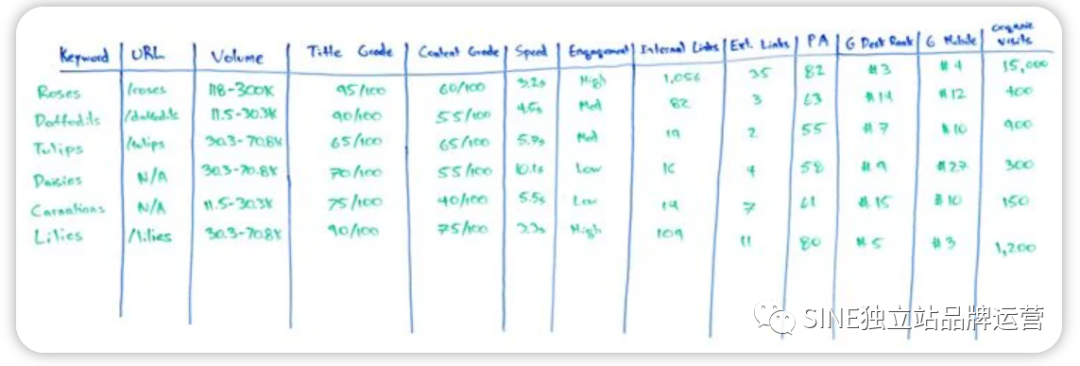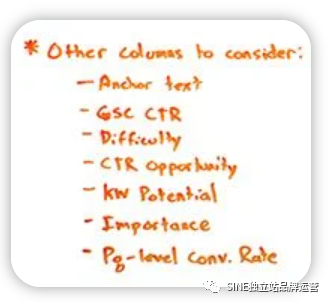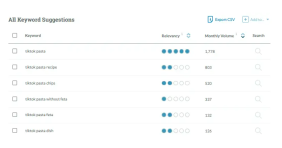您网站上的内容并非有意针对任何关键字。但是,您如何识别这些机会,最重要的是如何利用它们?

本周我们将讨论如何构建一个杀手级的内容到关键字的映射。现在,这几乎是每个 SEO 在对网站进行审计时都会做的事情,无论是在内部还是作为承包商或代理顾问。
我们试图在这里得到的是一张图片:这是我们试图定位的所有关键字。这是我们拥有的所有内容,也许我们有所有这些内容的关键字。也许其中一些内容没有关键字,诸如此类。我们正在尝试将这些映射在一起,以便我们知道哪些需要优化,需要构建哪些新内容,需要针对哪些关键字来匹配哪些内容,以及所有这些类型的内容。这就是我们如何确定 SEO 在新网站、新活动时应该做的优先事项和工作。
SEO制图

所以我在这里所做的是构建一个大的,但实际上这并不像您想象的某些内容到关键字的映射那样完整。我已经看到它们的列数是这些的两倍,我相信很多正在观看的人都会说,“哦,伙计,兰德,我的地图上还有更多。”
通常这是在 Excel 中完成或在 Google 电子表格中完成。任何一个都可以正常工作。不幸的是,目前没有很好的软件可以做到这一点。如果您在企业方面,您可以使用Moz 之类的工具或工具(例如Searchmetrics或Conductor)来获取大量此类数据。你可以从大量不同的地方提取数据,或者是那边的统计数据,无论是什么,OnPage.org。
列
但是您要在这里构建的内容基本上是我所有的关键字都映射到我的所有 URL。有时你可能会。. . 事实上,如果你正在做一个综合性的工作,你应该找到一些你没有一些关键词的 URL 的地方,因为一些关键词还没有被定位,但你仍然想为它们排名。您可能应该有一些没有关键字的 URL。从本质上讲,您还没有故意将关键字定位到该页面,这实际上可能会帮助您确定优先级并尝试执行其中的一些操作。
然后你会有这样的事情:这有多少搜索量?您将尝试估计或使用工具为您的标题、内容、可能是 URL 本身、加载速度和参与度打分。参与度可以是每次访问的网站或页面的浏览率或时间,也可以是所有这些内容的组合。
您可能正在查看页面的内部和外部链接。内部链接说,“内部链接有多好?我在那里有机会吗?” 外部链接说,“我排名还是不排名,因为我没有外部链接指向这里?”
我可能会查看诸如页面权限之类的内容来尝试汇总这些内容、Google 桌面和 Google 移动排名,以及该页面从搜索引擎收到的自然访问。

现在,您可以考虑添加更多的列。您可以添加以下内容:
锚文本,如果你要分析你的内部和外部的锚文本。
Google Search Console中某些关键字的点击率并将该数据添加到其中。我们都知道 Google Search Console,不是非凡的数据,但有时可能很有用。
如果您尝试优先考虑大型关键字研究功能,例如Keyword Explorer 中的内容,您可能会有更多关键字驱动的指标:
关键词难度
点击率机会
重要性得分,您的自定义重要性得分,您的潜力。您可能会根据这些类型对这些进行不同的排序。
页面级转化率。这对在我的网站上转换的内容有多大贡献?它直接转换的效果如何?那些东西。
继续路线
所以现在你已经有了这个大的内容到关键字的映射。“兰德,我为什么要建造这个?” 好吧,看,这张地图可以让你做一堆非常重要的事情,比如:
识别没有内容映射到它们的关键字。基本上就是说,“嘿,如果我想定位这个关键字,我最好构建一些内容。” 这是你需要做的工作。
确定页面上的改进机会。因此,您可能会查看某些内容或标题等级。你可能会去匹配排名,你可能会说,“等一下。我排名第 10。我的内容评分只有 40 分(满分 100 分)。该死,我可以很快改进。我可以把那个页面变成一个通过投资一些页面优化,效果会更好。”
或者,例如,您可能会说,“嗯,我在一堆这些指标上做得很好,但是男孩,页面加载速度真的很糟糕。看,我可以在桌面与移动排名中看到这一点。我' “我在桌面上的排名比在移动上好得多。也许加载速度是原因之一。” 我可以查看其他页面改进,例如“哦,伙计,参与度太低了。我敢打赌,低参与度会降低我的排名潜力。” 好吧,那两个。识别没有关键字定位的内容。所以我可能会在这里发现我有类似 /flowers 的东西,它在这里提供了我所有不同的选项,但我没有故意选择我的目标。我卖花送货吗?我应该瞄准那个吗?我是卖温室用花还是在你家后院种花?我应该瞄准那个吗?我这里的关键词是什么?射击,我还没有建立一个。通常,当您审核一个站点时,您会发现大量 URL 故意不针对特定关键字,但应该是。您需要做的就是进行一些优化工作,以帮助这些 URL 定位它们应该定位的关键字。
确定链接建设需求。所以我可能会看这里,我可能会说,“嗯,我的外部链接,哦,那太糟糕了,我的排名有点反映了这一点。我需要做一些链接建设。比如,那个页面不会排名。即使它在页面上做的很好,没有这个它就不会排名。
优先考虑并专注于您的工作,以便您在完成此审核后可以做最重要的事情,并且您可以真正推动 SEO 的发展。
如果您有很棒的想法或在内容到关键字的地图中做了很棒的事情,我很乐意看到它们。请把它们留在评论中。随意链接到事物。如果您想上传地图,请展示您的地图。我很想看到查看列以及您使用此地图的方式。希望在未来,也许我可以说服 Moz Pro 软件人员为您构建这个。;-)
Gianluca Fiorelli
Answering to your questions:
1) Do you use this methodology? If not, what do you use to prioritize which SEO work (for specific pages/keywords) to do next?
I do... a lot.
Actually, along with crawling the site and analyzing its log file, this is the third basic analysis I do, and I use it for then elaborating:
Content audit and therefore strategy, where I usually:Consider how to improve the effectiveness of existing content (if not changing entirely its purposes; for instance changing the nature of the keywords it is targeting from informational to transactional or from top to middle of funnel or bottom of the funnel);Try to individuate gaps and missed opportunities, so to suggest the creation of content (or even sections) that are missing in order to enlarge the keywords targeted by the site.On Page Analysis and Optimization.
2) If you do build spreadsheets like this, what tools do you currently use to get the data? How much of it is manual?
Information retrieval is mostly based on tools, many of which you cited in the WBF. I'd add SISTRIX to the tools mix in the discovery phase and SEMRush and Similarweb, these two also for discovering what keywords competitors are targeting, which my site is not.
Another tools I use, then, is URL Profiler, which is great - thanks to its ability to connect to many tools via API - for retrieving URL based metrics.
Finally I consolidate all the collected data in a Excel file for working.
3) What columns or what types of data do you currently use (or what would you love to have in a tool that did this for you if Moz or another software provider built it)?
You listed almost all the columns I use too, both in the spreadsheet and the suggested columns below it.
Of the suggested ones, I would add the "Impressions" metric that GSC offers, because in combination with rankings and CTR, it can tell us if a Search Snippet is not offering the desired results.
Another column I add is the "Level" one, meaning with level in what level of the site the mapped URL is present. This data can be useful especially for understanding if the page is not ranking as well as its maybe good optimization would make us think of, hence considering if a better internal linking from higher levels of the site could give it that boost we are aiming for the URL in the SERPs.
In some cases, I also create a column where I specify what phase of the funnel the keyword and page are targeting (TOFU, MOFU, BOFU)
Finally, I usually create an Excel file with 3 spreadsheets' tabs:
1) All the keywords;
2) Branded keywords;
3) Non Branded keywords.
P.D.: setting reminders in my Calendar for asking you and the Moz Pro product team if you started working on a product like this every now and then :D.
来源:moz
文章为作者独立观点,不代表DLZ123立场。如有侵权,请联系我们。( 版权为作者所有,如需转载,请联系作者 )

网站运营至今,离不开小伙伴们的支持。 为了给小伙伴们提供一个互相交流的平台和资源的对接,特地开通了独立站交流群。
群里有不少运营大神,不时会分享一些运营技巧,更有一些资源收藏爱好者不时分享一些优质的学习资料。
现在可以扫码进群,备注【加群】。 ( 群完全免费,不广告不卖课!)







发表评论 取消回复